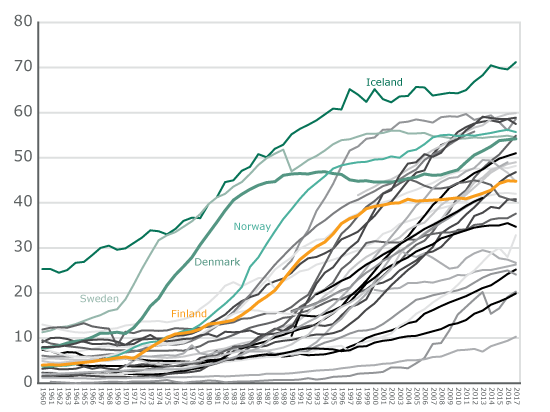Non-marital childbearing has increased substantially in most European countries. Over time, developments such as urbanisation, economic independence of women and high unemployment rates particularly among men may have diminished the social and economic significance of marriage, while the ideational climate changed and made childbearing outside marriage socially acceptable. Nordic countries have been forerunners in this development (Figure 1). In the 1970s and 1980s, they stood out in European comparison with their high levels. More recently, the levels in many other countries have risen equally high or even higher.

Figure 1: Non-marital Births (%), 1960-2017, European Countries. Source: Schnor and Jalovaara (2019).
Many studies show that low educated women and men are especially likely to have their children outside marriage, whereas highly educated persons tend to marry before childbirth. In the past decades, the average level of education has increased (especially among women), and the proportion of low educated people has sharply declined in roughly all Western countries. Paradoxically, these countries have seen at the same time a substantial increase in non-marital childbearing. How could these trends go together? In a new study, Christine Schnor and Marika Jalovaara provide the missing link between individual behaviour and macro family trends.
Using register data on Finnish first-time parents (mothers and fathers), the authors examined the increase in non-marital childbearing over the period 1970–2009. Their descriptive analysis reveals that the overall increase in non-marital childbearing is mainly due to increases in non-marital childbearing rates among the medium-educated population, contradicting previous evidence on the key role played by lower educated individuals.
Even if they also found that the highest proportion of non-marital first-time childbearing was indeed among the low-educated, the overall contribution of this group was small or even negative due to a shrink in this group size over time. The contribution of highest educated (those with a master degree from university) women to non-marital childbearing remained low. However, women with some tertiary education (vocational college or university bachelor’s degrees) contributed substantially to the increase. Taking women with different levels of tertiary education together (as in most studies), they account for approximately half of the increase in non-marital childbearing in recent decades. Fathers are most commonly medium-educated, and this group contributed most to the increase in non-marital childbearing among fathers.